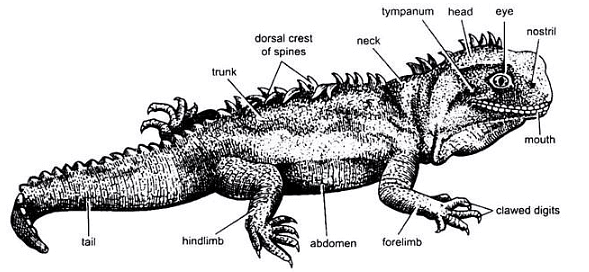UPSC Exam > UPSC Notes > Zoology Optional Notes for UPSC > Reptilia: Sphenodon
Reptilia: Sphenodon | Zoology Optional Notes for UPSC PDF Download
Sphenodon Anatomy: Vertebrates in the Chordata Phylum
Distribution of Sphenodon
Sphenodon punctatum, commonly known as Tuatara among native Maories, represents the sole surviving member of the Rhychoceplia order, once prevalent around 200 million years ago. Originally widespread in New Zealand, its population dwindled due to the influence of terrestrial mammals, including humans. Presently, Sphenodon is confined to coastal islands, where it burrows into soft soil, primarily emerging at night. Legally protected, it stands as an unaltered "living fossil," embodying diapsid conditions from the late Permian era.

Habits and Habitat of Sphenodon
Sphenodon dwells in burrows within soft soil and rocks, often sharing its habitat with petrels, showcasing nocturnal behavior. As carnivores, they feed on invertebrates and fish, displaying slow movements but capable of swift runs and robust self-defense. Egg-laying occurs from November to February, with a prolonged incubation period of 13 months. Sphenodon's captivity survival extends up to twenty-eight years.
External Characteristics of Sphenodon
Measuring approximately 60 cm, Sphenodon resembles a lizard-like reptile with scaly skin, a laterally compressed tail, and pentadactyle limbs adapted for walking.
- Granular scales cover its upper surface, forming spines along the median row from head to tail (excluding the neck).
- Dull olive-green with white and yellow spots, it features large, dark brown eyes with a vertical pupil.
- Monocular vision is observed, and the transverse anal opening lacks hemipenes in males.
Anatomical Features of Sphenodon
Endoskeleton:
- Vertebrae are amphicoelous, retaining notochord remnants in intercentral spaces.
- Bony elements from ossification of ventral portions of intervertebral discs represent intercentra.
- Caudal vertebrae exhibit fused caudal ribs.
- Lizard-like skull with a complete lower temporal arch.
- Fixed quadrate wedged between quadrato-jugal, squamosal, and pterygoid.
- Unfused premaxillae separated by a suture, broad palate formed by vomers, palatines, and pterygoids.
- Pubes of the pelvic girdle unite in a symphysis, with a cartilaginous epipubis in front.
- Distinct yet firmly united tibial and fibular elements in the tarsus.
- Presence of 3 distal tarsal bones.
Alimentary Canal of Sphenodon
- Pointed, triangular, laterally-compressed teeth in two parallel rows along the maxilla and palatine.
- Teeth wear down in adults, forming continuous ridges.
- Respiratory system includes an elongated trachea dilated to form the larynx, emitting a soft frog-like croak.
- Lungs resemble lizard-like structures.
Cardiovascular System of Sphenodon
- Sinus venosus is not externally distinguishable, and the structure aligns with other lizards.
- Jacobson's organs in a relatively primitive form.
Specialized Organs and Features in Sphenodon
Parietal or Pineal Eye:
- Situated in the parietal foramen, the median pineal eye develops in association with the epiphysis.
- Possesses a lens and retina supplied by a nerve from the brain.
- Not externally visible but observed in the aural region after skin removal.
- Tympanic cavity represented by a large pharyngeal recess.
Systematic Position of Sphenodon
Sphenodon (Rhynchocephalia), originating in the Permian, stands as the oldest known reptiles.
- Often considered an ancestral group or closely related to reptile ancestors, it shares resemblances with lizards, Crocodilia, Dinosauria, and Chelonia. Labeling it a "living fossil" underscores its persistence and relatively minor evolutionary changes compared to most reptiles.
- Found in an isolated island region, Sphenodon reflects both primitive and modified characteristics, earning its classification in the separate order Rhynchocephalia.
The document Reptilia: Sphenodon | Zoology Optional Notes for UPSC is a part of the UPSC Course Zoology Optional Notes for UPSC.
All you need of UPSC at this link: UPSC
|
181 videos|351 docs
|
Related Searches
















